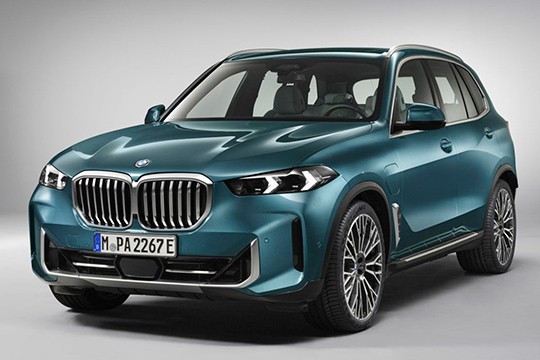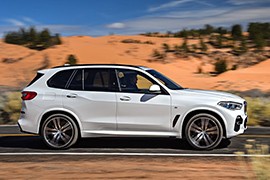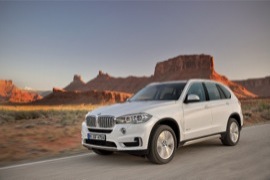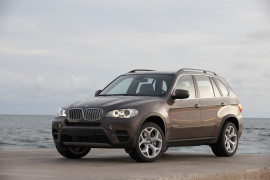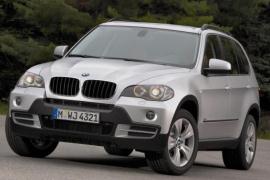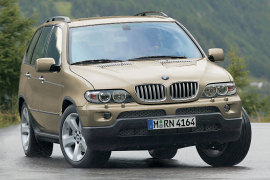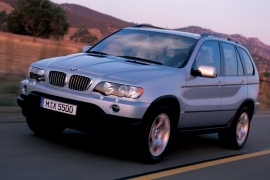BMW X5 Models/Series Timeline, Specifications & Photos
First production year: 2000
Engines: Mild hybrid, Mild hybrid diesel, Hybrid gasoline, Gasoline, Diesel, Hybrid
Body style: SUV (Sports Utility Vehicle)
BMW introduced a facelifted version of the X5 in February 2023, bringing some exterior changes, a more significant interior upgrade, and 48V plug-in hybrid drive systems.
Ever since the model's introduction on the market back in 1999, the X5 has enjoyed great success. Soon, it was the talk of the day at every automotive gathering since everyone was asking why BMW started to make SUVs. But the waiting lists for these vehicles were high. The high-rider drove like a car, provided an MPV-like interior space, and was luxurious in many ways. But fast forward to 2023, the car was already at its fourth generation's facelift, and the sales were still consistent. Yet, the automaker considered that it was time for a change.
At the front, the headlights got slimmer, and the v-shaped turn signals/daytime running lights pointed outwards replaced the former hexagonal-shaped ones featured in the 2020 model year. In addition, the front bumper was changed and sported a lower U-shaped grille flanked by slim and tall vertical air inlets that channeled the air to the sides of the vehicle. At the back, the automaker installed new taillights.
But it was the interior that went through a major upgrade. The instrument cluster consisted of a 12.3" digital panel and a 14.9" center display for the infotainment unit. Both were covered by the same curved piece of glass. In addition, the X5 also boasted the iDrive 8 operation system. BMW also installed standard sports seats for the front passengers. Previously, these were offered as an option. Last but not least, specific versions could be ordered with a third row of seats.
Under the hood, the German automaker introduced a mild hybrid system for the diesel version. At the same time, BMW offered a choice of three gasoline engines that also benefited from electrification.
The fourth generation of the BMW X5 was introduced in 2018 and, after 2.2 million units sold from its previous three generations, it reached a high level of maturity.
The BMW X5 was one of the most popular premium SUVs on the market. Its high volume of sales convinced the German car-maker to improve the vehicle up to a level hard to reach by any of its competitors.
The massive grille design of the 2018 BMW X5 was not on everyone's taste. The headlights design was slimmer and in the same aesthetic trend as the rest of the BMW range. They came with LED as standard while BMW Laserlight with Adaptive LED Headlights was available as an option. The car featured standard 18” light-alloy wheels for the base trim level. The rear split tailgate was kept and was offered with standard power opening and closing.
Inside, there was room for five adults and a split rear bench backseat int 40:20:40 scheme. There were plenty of USB ports and 12V plugs in the rear. An option for two 10.2” touch-screen displays was available for the rear-seat entertainment. In the front, the driver had a digital instrument cluster with a TFT instead of analog dials. On the center console, there was the infotainment unit and screen. It could be activated by voice-commands, gestures, steering wheel buttons, and the iDrive rotary knob on the center console.
The engine ranged from a 2.0-liter turbocharged diesel up to a 4.4-liter V8 turbocharged gasoline unit. While the former was not available in the U.S., the latter was not produced for Europe. The standard transmission was an 8-speed automatic gearbox. More performance models were available fitted with either 3.0-liter diesel engines or the M-version.
In 2014, BMW came with the third generation of its revolutionary SUV that held the crown for the sales in its segment. Considering this, it had to be one step ahead of the competition.
In times when all the 4x4 vehicles were big and chassis-based, BMW took the chance when it owned the Land Rover brand and, with their know-how, the BMW engineers built an SUV with no transfer case, no low-gear and with unibody construction, unlike its main rival that built the first-generation of ML on a ladder-chassis.
The look of the 2014 X5 was clearly a BMW. The kidney-grille on the front was bigger than before, and they were extended from one headlight to another. It featured optional Adaptive LED headlights, identified by a horizontal light source on the center of the light rings. For the X5 5.0i and the X5 M50d, the xenon headlights were standard.
Inside, the high seating position allowed the constructor to design a very roomy interior. It was a truly 5-seater vehicle The infotainment unit had a 10.25” color display, controlled via the standard iDrive rotary knob from the center console. There were few options for that, and one had a touch-pad on top of the knob to write the names or the numbers of an address for the navigation system.
For the first time, the X5 was available with a small, 2.0-liter engine and with rear-wheel-drive only. But the top performers had over 400 hp and plenty of torque to deal with. The standard transmission was an 8-speed automatic. The X5 also had a plug-in hybrid version.
The German automaker introduced the second generation of the X5 in 2007 and didn't wait too long to give it a refresh just three years later.
While the engineers hurried to make the engines compliant with the Euro 5 emission standards, the design team didn't work too much. In fact, only hard-core BMW fans could notice all the changes between a facelifted and a non-facelifted version of the X5 (E70). Or to keep the carmaker's specific designation, the LCI (Life Cycle Impulse). Nevertheless, the big SAV (Sports Activity Vehicle) was successful, and it sold in big numbers even though the world was struggling with a financial crisis.
On the outside, the 2010 X5 featured a new front bumper with larger air intakes to cool the brakes and the engine. Furthermore, BMW installed satin-silver trims on the side scoops and a shield-like plastic element at the bottom of the bumper. In the rear, the X5 showed similar-looking taillights, although there were more LEDs than on the 2007 model. Last but not least, the rear bumper was also redesigned and sported a wider body-colored area than on its predecessor.
Inside, at first sight, it was the same car, but that impression lasted until the owners turned on the infotainment system. It was a new iDrive, and its menus were much more intuitive. But the rest of the cabin remained basically the same. BMW offered an option for a third row of jump seats placed in the trunk area.
But the most significant changes happened under the hood, where BMW installed a new range of engines. Moreover, the carmaker ditched the formerly used six-speed automatic and replaced it with a newer and better eight-speed automatic gearbox. Depending on the version and options, the X5 was fitted with all-wheel drive or just rear-wheel driven wheels.
The German carmaker introduced the second generation of the X5 in 2007, improving the entire vehicle from top to bottom.
While the first generation of the X5 was based on the BMW 5-Series E39, its successor came with a new platform. Apart from the height, all of the other measurements were increased. Thus, the second generation of the X5 became the first BMW to offer a 7-seat option in the German carmaker lineup.
The flame-surfacing design concept imagined by Chris Bangle was at its peak when the X5 was introduced in 2007. With its big headlights and flowing lines, the German SUV didn't want to look streamlined, but massive. The bulky grille and the "BMW kidneys" were more significant, and the fenders were wider.
The interior offered room for five adult passengers, with an option for an extra row of seats in the back for another two. The manufacturer installed an instrument cluster with four dials and a small screen for the on-board computer for the driver. As an option, the iDrive infotainment unit was offered in a few versions, the top one offering sat-nav and a premium sound system.
Under the hood, BMW installed a choice of diesel and gasoline engines with 6 and 8 cylinders, providing a power output ranging between 235 hp and 355 hp. All versions were offered with an all-wheel-drive system.
The first generation of the BMW X5 was introduced in 1999 and, following the success of SUV success, it prepared a major facelift for it that was introduced in 2003.
When BMW owned the Land Rover brand, it worked together with the British brand about how to build a successful SUV. Both brands had experience in luxury products, but only Land Rover had a true off-road heritage. The hill descent control, the split-tailgate, and the torque distribution method were parts that made the X5 a great success.
The X5 was based on the E39 5-Series platform and that kept the production costs lower. The design lines were taken from the 5-Series as well. At the facelift, a new set of headlights, grille, and bumpers were installed. The taillights were redesigned as well and new wheels were introduced.
Inside, there were not too many modifications. A new infotainment system was available, with a color display on the center stack. The GPS-navigation system was a good addition. A big, panoramic, roof was added to the options list.
For the engine compartment, the X5 received more powerful engines. The 4.6-liter V8 was replaced by a 4.8-liter unit. The diesel engine, which was the most demanded version on the European market was upgraded from 184hp to 218hp. The most important update to the drivetrain was the introduction of the 6-speed automatic instead of the older 5-speed, while the xDrive (all-wheel-drive) system was upgraded.
The 3 series started its career in the '70s only in coupe form but evolved over the years into a full line of bodyworks. But the coupe was not dropped and, in the third 3-series, the coupe played an important role in the market. It was shown in late 1990 and the sales started in 1991.
The E36 was a complete change in the 3-series design. From the exposed rounded headlights to newly developed twin headlamps under the same glass, it was a big step and many fans didn't agree with it. But the car was better from any point of view. The new suspension, bigger wheelbase and bigger engines were enough to place the car on top of the premium compact-sized sedans on the market. And the coupe went a step further with its doors with frameless windows.
The interior featured a dashboard turned toward the driver, with accessible controls and a good layout. The low sitting position was very well received by the customers who were looking for a true sports car at a decent price. In the rear, there was enough room for two adults. Depending on the trim level and options checked on the list, there were front highly bolstered seats, heated and power-adjustable.
Under the hood, the basic engine was a carry-over from the E30, but that changed from the facelift model that happened in 1995. The top model, apart from the M3, was the 328i version, with a newly developed 2.8-liter unit. The standard transmission for the entire range was a 5-speed manual and a 4-speed automatic was offered as an option.
